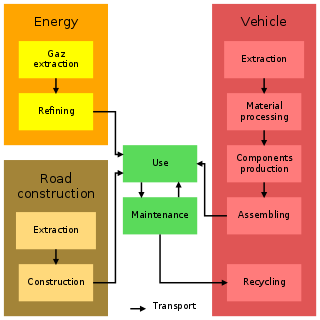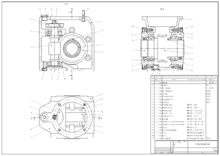Material requirements planning (MRP) is a production planning, scheduling, and inventory control system used to manage manufacturing processes. Most MRP systems are software-based, but it is possible to conduct MRP by hand as well.
Mass customization makes use of flexible computer-aided systems to produce custom products. Such systems combine the low unit costs of mass production processes with the flexibility of individual customization.

In industry, product lifecycle management (PLM) is the process of managing the entire lifecycle of a product from its inception through the engineering, design and manufacture, as well as the service and disposal of manufactured products. PLM integrates people, data, processes, and business systems and provides a product information backbone for companies and their extended enterprises.
Product data management (PDM) is the name of a business function within product lifecycle management (PLM) that denotes the management and publication of product data. In software engineering, this is known as version control. The goals of product data management include ensuring all stakeholders share a common understanding, that confusion during the execution of the processes is minimized, and that the highest standards of quality controls are maintained. PDM should not be confused with product information management (PIM).
Prefabrication is the practice of assembling components of a structure in a factory or other manufacturing site, and transporting complete assemblies or sub-assemblies to the construction site where the structure is to be located. Some researchers refer it to “various materials joined together to form a component of the final installation procedure“.
Design for excellence is a term and abbreviation used interchangeably in the existing literature, where the X in design for X is a variable which can have one of many possible values. In many fields X may represent several traits or features including: manufacturability, power, variability, cost, yield, or reliability. This gives rise to the terms design for manufacturability, design for inspection (DFI), design for variability (DfV), design for cost (DfC). Similarly, other disciplines may associate other traits, attributes, or objectives for X.
A contract manufacturer (CM) is a manufacturer that contracts with a firm for components or products. It is a form of outsourcing. A contract manufacturer performing packaging operations is called copacker or a contract packager. Brand name companies focus on product innovation, design and sales, while the manufacturing takes place in independent factories.

Modular design, or modularity in design, is a design principle that subdivides a system into smaller parts called modules, which can be independently created, modified, replaced, or exchanged with other modules or between different systems.
An engineering bill of materials (EBOM) is a type of bill of materials (BOM) reflecting the product as designed by engineering, referred to as the "as-designed" bill of materials. Some parts of BOM includes "Contengency Fund" an emergency fund when the as-designed materials shortage happened, inflation of materials are included if and only if. The Contractor Profit is the transparent Profit the Contractor or direct Engineer will receive at rural areas when the project is finished. The Manpower fund commonly called the Labor fund is also included in the BOM, these fund are commonly returned to the project owner when it excess as per as-designed BOM.
Product structure is a hierarchical decomposition of a product, typically known as the bill of materials (BOM). As business becomes more responsive to unique consumer tastes and derivative products grow to meet the unique configurations, BOM management can become unmanageable. For manufacturers, a bill of materials (BOM) is a critical product information record that lists the raw materials, assemblies, components, parts and the quantities of each needed to manufacture a product.
Diminishing manufacturing sources and material shortages (DMSMS) or diminishing manufacturing sources (DMS) is defined as: "The loss or impending loss of manufacturers of items or suppliers of items or raw materials." DMSMS and obsolescence are terms that are often used interchangeably. However, obsolescence refers to a lack of availability due to statutory or process changes and new designs, whereas DMSMS is a lack of sources or materials.
Engineer to order is a production approach characterized by:
- Engineering activities need to be added to product lead time.
- Upon receipt of a customer order, the order engineering requirements and specifications are not known in detail. There is a substantial amount of design and engineering analysis required.
Backflush accounting is a subset of management accounting focused on types of "postproduction issuing;" It is a product costing approach, used in a Just-In-Time (JIT) operating environment, in which costing is delayed until goods are finished. Backflush accounting delays the recording of costs until after the events have taken place, then standard costs are used to work backwards to 'flush' out the manufacturing costs. The result is that detailed tracking of costs is eliminated. Journal entries to inventory accounts may be delayed until the time of product completion or even the time of sale, and standard costs are used to assign costs to units when journal entries are made. The backflushing transaction has two steps: one step of the transaction reports the produced part which serves to increase the quantity on-hand of the produced part and a second step which relieves the inventory of all the component parts. Component part numbers and quantities-per are taken from the standard bill of material (BOM). This represents a huge saving over the traditional method of a) issuing component parts one at a time, usually to a discrete work order, b) receiving the finished parts into inventory, and c) returning any unused components, one at a time, back into inventory.

A bill of resources (BOR) describes a list of resources, such as labor, needed to complete a saleable product. It is used in capacity planning to prioritize and schedule work in manufacturing resource planning (MRP II) and enterprise resource planning (ERP) by highlighting critical resources. Critical resources are resources that are in short supply or that have long lead times.

Modular construction is a construction technique which involves the prefabrication of 2D panels or 3D volumetric structures in off-site factories and transportation to construction sites for assembly. This process has the potential to be superior to traditional building in terms of both time and costs, with claimed time savings of between 20 and 50 percent faster than traditional building techniques.
Final Assembly Schedule, often abbreviated as FAS and sometimes referred to as finishing schedule, is a schedule of end items to finish the product for specific customer orders in a make to order (MTO) or assemble-to-order (ATO) environment.
Knowledge-based configuration, also referred to as product configuration or product customization, is an activity of customising a product to meet the needs of a particular customer. The product in question may consist of mechanical parts, services, and software. Knowledge-based configuration is a major application area for artificial intelligence (AI), and it is based on modelling of the configurations in a manner that allows the utilisation of AI techniques for searching for a valid configuration to meet the needs of a particular customer.
Configuration Lifecycle Management (CLM) is the management of all product configuration definitions and configurations across all involved business processes applied throughout the lifecycle of a product.
Configure, price, quote (CPQ) software helps sellers quote complex and configurable products. An example could be a maker of heavy trucks. If the customer chooses a certain chassis, the choice of engines may be limited, because certain engines might not fit a certain chassis. Given a certain choice of engine, the choice of trailer may be limited, and so on. If the product is highly configurable, the user may face combinatorial explosion, which means the rapid growth of the complexity of a problem. Thus a configuration engine is employed to alleviate this problem.
The guideline committee VDI 2343 "Recycling of electrical and electronic devices" was initiated in 1996 by Ralf Brüning. The aim is to develop practical and legally compliant recommendations for action in order to support the affected groups in their work, for expample disposal companies, manufacturers, universities, authorities, lawyers, environmental associations, reuse companies. Thereby among other things the aspects of logistics, dismantling, processing, recycling and reuse are dealt with in seven sub-committees and coordinated in an overall committee.




